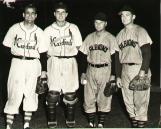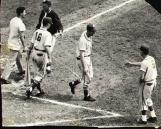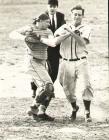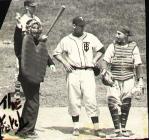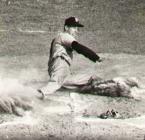1
The Stellarton Albions were the dominant club in the H&D league during the early 1950s, winning three championships in a row from 1951 to 1953. By this time the old Central League had disbanded and the H&D league now comprised six teams; the Albions, Dartmouth Arrows, Halifax Capitals, Kentville Wildcats, Liverpool Larrupers, and Truro Bearcats. Stellarton's rise to ascendancy had really begun in 1950, however, when former Kentville shortstop Johnny Watterson agreed to take over as the Albion's pilot. A native of Marlboro, New Hampshire, Watterson had played periodically with nearby Keene in the old Northern League.While preparing his roster for the 1950 season Watterson received a phone call recommending that he sign Bill Brooks, a twenty-six year old catcher from Wilson, North Carolina. Brooks had played with the Keene Blue Jays in 1949, but had a veteran's resume, including a starring role with the 1945 United States National Service champions Enid Airs, three years in the Coastal Plains League as chattel of the New York Giants, and a brief stop with Manchester of the New England League.
As Brooks and his wife drove north to Nova Scotia on what seemed like an endless trip over bad roads, he had no idea that Stellarton would be his summer home for the next four years, nor that he would be at the helm of a club that would rank as the best in the history of the league. In 1950 Brooks had a solid season, hitting .271 in 188 at bats, but it was his maturity that drew attention.
2
Team photograph of the 1951 Stellarton Albions, Halifax and District Baseball League champions.1951
Albion Field, Stellarton, Nova Scotia
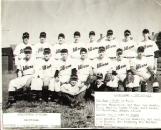
3
When Watterson received a military draft notice in 1951, club management turned the reins over to Brooks. During the next four seasons Brooks showed the leadership qualities that would serve him later in life as longtime baseball coach and athletic director at UNC Wilmington. The arrival of Brooks also marked the beginning of a southern connection that would characterize the league during the remainder of its existence.Looking around the infield from his position at first base, Brooks was happy with the team he'd assembled for the 1951 season. The majority of his players were members of the Wake Forest College club from Raleigh, North Carolina, NCAA national finalists in 1949. In addition, most of his recruits had also played in the strong semi-pro Albemarle League which collapsed in 1950 leaving a rich pool of talent for Brooks to draw from.
At second base was Kent 'Baby' Rogers who, despite his diminutive stature, was a natural athlete, good fielder and line drive hitter. Hailing from the mining districts around Hinton, West Virginia, Rogers had spurned pro offers from the St. Louis Cardinals and New York Yankees after high-school. Instead he accepted a scholarship to Wake Forest where he was the 'baby' on a team of war vets going to university on the G.I. Bill.
7
At shortstop 6'1" 190 pound Gair Allie moved gracefully across the interior of the diamond showing the range that made him a Branch Rickey protégé. Allie would be the Pittsburgh Pirates starting shortstop in 1954. Another Wake Forest product, Allie had been a last minute addition to the Albions, coming north with the blessing of the Pirates who hoped to hide him from other organizations by having him play in Nova Scotia for the summer.Next to Allie on the hot corner stood strapping third-baseman Huck Keaney from the Boston area, one of the few Stellarton regulars not from the south. One of a number of University of New Hampshire players in the league at the time, Keaney was the only hold-over from the Albions infield the year before. He .261 in 218 at bats in 1950.
The rest of the lineup included Albemarle League veteran and Duke University catcher Leroy Sires who would force Brooks to move to first-base from behind the plate, and a trio of Wake Forest outfielders Art Hoch, Joe Fulghum, and Johnny Alford. On the mound the Als sported UNC star Joel Pazdan, ex-pros Vern "Preacher" Musdian and Ray Moring, Don Woodlief, Joe Kucharetz, Andy "Lefty" McAuliffe, and.local product Sid Roy. Earlier Brooks had signed Billy Joe Davidson, but he was lost to the Als when the Cleveland Indians offered him a $120,000 signing bonus.
10
The only home-brews to play on a regular basis that year were Harry Reekie who started in right-field and pitcher Sid Roy who won eight games in ten decisions. First-baseman John "Brother" Macdonald would play only sparingly because of Brooks' moving to first base. Here was another unfortunate case of a talented local player being pushed aside as the league concentrated on importing players from the United StatesOutfielder Joe Fulghum was the league's dominant player in 1951, capturing his first batting title and leading the league in hits, runs batted in, and runs scored. No one in league history, with the exception of Buddy Condy, would be more feared at the plate. During his five years in Nova Scotia Fulghum won two batting championships and compiled a career league batting average of .361. (An arm injury in college had dashed his pro aspirations, although today Fulghum would have made a good designated hitter.).
Like "Big Joe" Fulghum, Art Hoch would become a fixture of the league over the coming years. Hoch chipped in with a .309 average in 1951, and was solid in his position in left field. Although he was an All-American shortstop at Wake Forest in 1946, blessed with good range and a bullet arm, Hoch moved to the outfield to make room for Gair Allie. Allie hit .291 over the season, and supplied power for the Albions, stroking a league record 19 home runs.
12
Many American college players were taking the place of home grown Nova Scotia talent in the league.1952

13
During the 1951 regular season the "Wake Forest North" Albions chocked up 45 victories against only 16 defeats, winning the league title by more than 12 games. They then proceeded to sweep both the league and provincial playdowns.In 1952 Reekie and Roy both returned to the squad, joining returning imports Brooks, Rogers, and Fulghum. Gone from the 1951 club were two of its best performers; Allie, who had signed with the Pirates and was assigned to New Orleans of the Southern League, and Hoch, who accepted a flattering offer to coach the Truro Bearcats. In other moves Leroy Sires gave way to Albemarle League grad Toomey Brooks (brother of Bill) and Wake Forest third-baseman "Doc" Murphrey took over from Huck Keany. Keany was particularly resentful of being let go after two solid seasons with the Als, but Brooks wanted to build upon the club's Carolinian connection that had worked so well the year before.
Before the 1952 season Brooks lined up a number of other capable replacements from Dixie. One of them was Duke University shortstop Dick Groat, who agreed to come as Allie's successor. Unfortunately, Groat was offered a contract with the Pittsburgh Pirates that spring and headed directly to the majors, where he hit .284 as Pittsburgh's regular shortstop. Ironically, when Groat spent the next two years in military service, Allie would be his replacement for the 1954 season in Pittsburgh.
14
Halifax Cardinals Levinson and Wilkinson with Stellarton Albions Raines and Bachelor1954
Wanderers Grounds, Halifax, Nova Scotia
